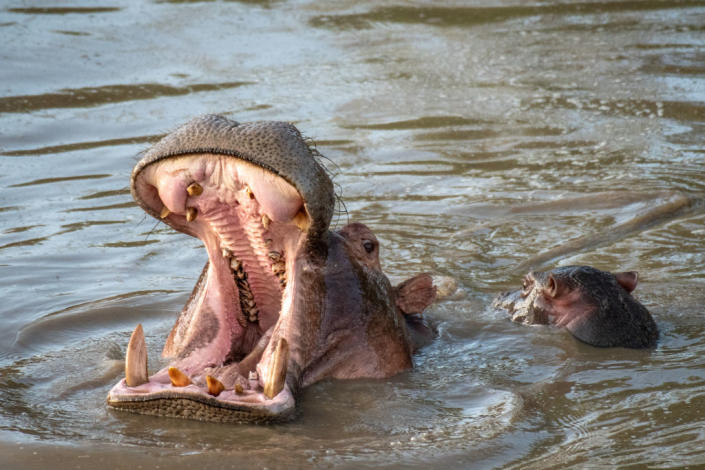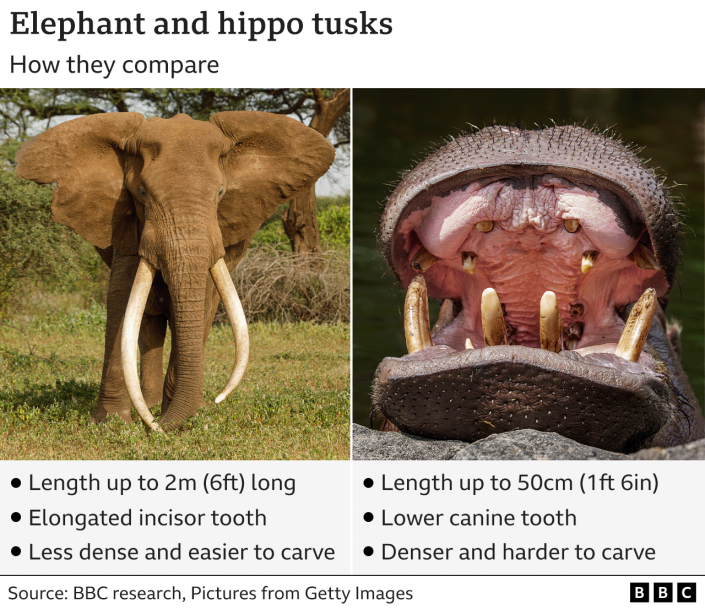
Deepening restrictions on ivory trafficking have led to an increase of the trade in hippopotamus teeth, wildlife campaigners are warning, with potentially serious effects for a species already listed as “vulnerable to extinction”.
When the UK last June announced a near-total ban on the trade in elephant ivory, an animal welfare charity studied what happened in three widely used online marketplaces.
“We found the increase in hippo ivory trade in the UK within a month after the near total-ban of elephant ivory was introduced,” says Frankie Osuch, lead author of a report released by Born Free in September.
This was “deeply concerning evidence of increased demand for ivory from hippos, whose numbers in the wild are under threat” the report said.
Researchers say this pattern was clear as far back as 1989, when a worldwide ban on trade in ivory was first agreed, and has only intensified as governments have brought in new measures to tighten the ban.
Like ivory, hippo teeth and tusks are often used for decorative carvings, but they are cheaper and easier to obtain.


Hippo body parts can still be traded under the Convention on International Trade in Endangered Species (CITES), though all international sales require an export permit.
It’s been calculated that between 1975, when CITES records began, and 2017, 770,000kg of hippo teeth were legally traded. But there is also an illegal trade.
In 2020 hippo teeth were among the mammal body parts most often seized in the EU, according to a European Commission report.
“There are increasing cases of sniffer dogs detecting hippo teeth at different airports in Africa these days, and the detection does not mean all of them are caught, perhaps only half of them are,” says Philip Muruthy, vice-president of the Africa Wildlife Foundation.
A study by the International Union for Conservation of Nature (IUCN) in 2016 estimated that the worldwide population of the common hippo was between 115,000 and 130,000 – a drop of 30% since 1994.
Ten countries in West and Central Africa say there has continued to be a sharp decline in numbers, due to poaching and land degradation.
They proposed a complete ban on trade in the run-up to a CITES meeting in Panama last month, but this would only have been possible under CITES rules if there had been more than 50% drop in the population in the last 10 years, and an IUCN analysis did not support this conclusion.
The 10 West and Central African countries then suggested a move called “annotation” that would have resulted in a zero-quota for wild specimens traded for commercial purposes. But this proposal was not supported by the EU or by East and South African countries, who say hippo populations remain at a healthy level.
Some of the East and South African countries – Tanzania, Uganda, Zambia and Zimbabwe – are also the source of three-quarters of the estimated 13,909 hippos whose parts and products were traded between 2009 and 2018.


Joanna Swabe, senior director of public affairs with Humane Society International, points out that little work has been done since 2016 to establish hippo numbers.
“There has been very little scientific research on the actual population of hippos in all of these range countries,” she says. “While at the same time, range countries know what is going on with their hippos within their territories, so they should not be ignored.”
Hippos have a low birth rate, producing only one offspring every other year, so a reduction in population size can have a long-term impact.
Hippo facts
-
All hippos live in Africa – there are two types, the common hippo (population estimated at 115,000 to 130,000 in 2016) and the pygmy hippo (2,000-3,000)
-
The common hippo was classified as “vulnerable to extinction” on the International Union for the Conservation of Nature (IUCN) red list in 2016
-
The parts and products of an estimated 13,909 hippos were legally traded between 2009 and 2018 – three-quarters of them originated in Tanzania, Uganda, Zambia and Zimbabwe
-
770,000kg of hippo teeth were legally traded between 1975 and 2017 – the size of the illegal trade is unknown
Wildlife experts also say that the legal and illegal trade in hippo teeth needs to be closely monitored.
The common hippo is listed in Appendix II of CITES meaning that it could be threatened with extinction unless trade is closely controlled.
The 10 countries seeking a worldwide ban on trade note argue that there is strong evidence of the “co-mingling of legal and illegal hippo ivory”, suggesting that poached ivory is “laundered into the legal market”.
Without stronger controls, campaigners warn, hippos may share the fate of elephants, which have become endangered – or critically endangered in the case of the African forest elephant – because so many were killed by poachers for their tusks.




